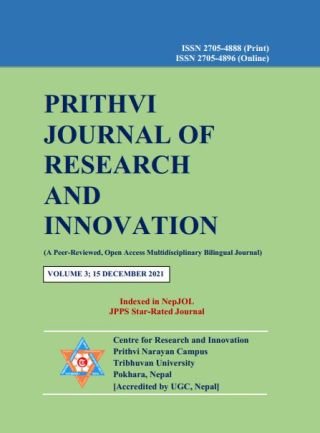A Comparison of Antibacterial Potential of Different Soil Actinomycetes from Pokhara
DOI:
https://doi.org/10.3126/pjri.v3i1.41625Keywords:
Actinomycetes, Antibiotics, agricultural land, lake bank soil, forest landAbstract
Actinomycetes are widely distributed in the environment and used for the production of several important secondary metabolites like antibiotics, immunosuppressive agents, enzymes and antitumor agents. Therefore, the main objective of this study is to isolate and assess antibacterial potential of different actinomycetes obtained from different soil samples. This study was conducted in the microbiology laboratories of Prithvi Narayan Campus and Lambda Food Lab Pvt Ltd, Pokhara. A total of nine soil samples were collected from different places of Pokhara (forest land, agriculture land and lake bank) and processed. Isolated actinomycetes were screened by primary and secondary screening for antibiotic producers against test organisms like Staphylococcus aureus (ATCC 25923), Pseudomonas aeruginosa (ATCC 27853) and Bacillus spp, E coli (ATCC 25922). This study isolated 27 actinomycetes in total, using the soil samples through spread plating on Starch Casein Agar (SCA) and by serial dilution. After incubation, actinomycetes colonies (rough, chalky) were selected for gram staining to observe thin thread-like mycelial and hyphal structures. The highest number of actinomycetes isolates were obtained from agricultural land’s soil samples (14 out of 27 isolates i.e. 51.85%) whereas only 3 isolates were obtained from the lake soil. Primary screening was performed on Nutrient agar where test bacteria were streaked perpendicular to the isolated actinomycetes to observe antagonism. This showed 12 actinomycetes as active isolates inhibiting at least one test bacteria. The antibacterial compounds were extracted by ethyl acetate method and used in secondary screening. Secondary screening in Mueller Hinton agar (MHA) further revealed five isolates showed promising inhibitory capacity. In both screening methods higher sensitivity was observed towards Gram-positive bacteria especially S aureus (ATCC 25923), and the least sensitivity towards Gram-negative bacteria especially Pseudomonas aeruginosa (ATCC 27853). Agricultural land was shown to harbor more actinomycetes than forest land and lake bank soil. Though variations were observed in primary and secondary screening, actinomycetes obtained from agricultural land demonstrated an inhibitory action against the Gram-positive and Gram-negative test organisms. As compared to Gram-negative bacteria, the Gram-positive had higher effects. These findings showed that soil of different locations of Pokhara valley found many actinomycetes strains, preventing the growth of pathogenic bacteria of certain kinds. The study suggested that further investigations need to be done that helped obtain new antimicrobial agents from actinomycetes, using various other sources.
Downloads
Downloads
Published
How to Cite
Issue
Section
License
Copyright (c) 2021 Centre for Research and Innovation (CRI), Prithvi Narayan Campus (TU)

This work is licensed under a Creative Commons Attribution-NonCommercial 4.0 International License.
© Centre for Research and Innovation (CRI), Prithvi Narayan Campus (TU)

